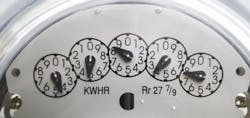Is it the typical one-to-three-year payback? That's better and more certain than most other corporate investments, and with prices bound to rise in the long term, it will increase over time. So it's not because energy efficiency projects aren't worth doing.
"It's because of internal barriers," Langlois told attendees of his session, "Developing Energy Efficiency Projects Using Energy Performance Contracting," this week at ABB Automation and Power World 2012 in Houston. Langlois asserted that in a typical manufacturing company, the combination of lack of awareness, lack of knowledge, lack of capacity (no one is dedicated to the task) and, perhaps especially, lack of financing and lack of confidence in obtaining the promised returns add up to—doing nothing.
That barren field has become fertile ground for the energy performance contract (EPC), defined by Langlois as "a contractual arrangement between a beneficiary (your company) and a provider called an energy service company (ESCO) for the implementation of an energy efficiency project, where the global investments have to be paid for through a contractually agreed level of energy cost reduction."
EPCs come in several flavors. Under a "guaranteed savings" contract, the end user company finances the project and the ESCO guarantees the returns. Results are measured and verified during an expected payback term, typically three or five years, and any shortfall is paid by the ESCO.
Under a "shared savings" contract, the ESCO finances the project and takes the lion's share of the savings for a defined period. The end user has no up-front cost. "You will never have a deficit and will have an immediate savings as well, from Day One," Langlois says, "along with better equipment and production." This approach has been very popular in the United States, involving "probably 20,000 projects over the past 10 years," Langlois said.
A third contract format, "chauffage," has the ESCO taking over an energy-related asset or system, such as a boiler or compressed air, and providing its output to the plant under agreed-upon terms. The ESCO pays an equity share—typically 10% to 30% of the assessed value of the asset—then finances, implements and owns the improvements.
| * Baseline construction costs equal 100%. | ||
| Category | Cost | Percent* |
| Investment grade audit | $35,000 | 4.5% |
| Construction costs | 785,000 | 100 |
| Engineering | 87,000 | 11.1 |
| Adm. & project manager | 87,000 | 11.1 |
| Profits | 60,000 | 7.6 |
| Guarantee premium | 50,000 | 6.4 |
| Training | 15,000 | 1.9 |
| Interim financing | 9,000 | 1.1 |
| Sub-total (TCI) | 1,128,000 | 143.7 |
| M&V | 34,000 | 4.3 |
| Financing | 357,000 | 45.5 |
| Total Project Costs (TPC) | $1,519,000 | 193.5% |
So ESCOs have become proficient at alternative financing, drawing on one or a combination of the end user, the ESCO, leasing and special-purpose vehicle (project) financing. This non-technical aspect of energy efficiency projects is not a strength of most engineering and operations teams, so it's an important ESCO capability for enlisting the folks in finance and accounting.
Since a major benefit of the EPC is the guarantee of savings, measurement and verification (M&V) becomes critical. Langlois said, "You can't measure savings because it's not there." Instead, you measure and establish a consumption baseline before the project, measure the consumption after the project, and calculate an estimate of the savings. Post-project measurements must be adjusted for any differences—weather, production rates—between the baseline and current conditions.
"The most critical part is to agree on how these adjustments will be done," Langlois said. That agreement must be in place before the project is performed, because it affects how the baseline measurements will be taken and for how long. "Once the project is done, the baseline is gone—you can't go back and take more measurements."
Baseline measurements might be possible using only the utility metering, as in the case of an office where the primary adjustment would be weather, or it may require additional metering, as in a complex facility where the energy savings due to, say, replacing motors might be impossible to separate from other consumption variations from product mix or equipment condition or operation.
Baseline measurement periods may be brief, as for a motor replacement where efficiency is essentially constant over the equipment lifetime, or may have to be extended to account for equipment efficiency variations due to, say, product mix, weather or maintenance. A good resource for understanding M&V and how it affects baseline measurements is the International Performance Measurement and Verification Protocol (IPMVP).
To decide if you need an ESCO to help you get an energy project done, bear in mind that it will add some cost to the project compared to doing it all internally. Langlois estimated the additional cost for the ESCO's profit adds about 8% of the construction costs, and guaranteeing the results adds about another 6%. But the rest of the project costs are about the same as they would be if you did them with your own company resources.
The biggest cost—and risk—is doing nothing.
About the Author
Paul Studebaker
Paul Studebaker

Leaders relevant to this article:



